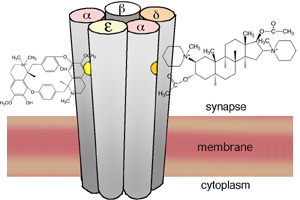|

Another project employs a Monte Carlo simulation program (MCell) to model the behavior of biological synapses. Here, we compared the diffusion of a reversible antagonist (A) with an irreversible antagonist (B) into a narrow synaptic cleft containing a high density of receptors. Antagonist-bound receptors are red, antagonist-free receptors are green. The different patterns of receptor occupancy may help explain why reversible ACh receptor antagonists such as curare, cause fade at the neuromuscular junction but irreversible antagonists such as αBTX do not. (Dilger, Biophys J. 2010, 98:595). Movie
|
 A recent project from the Dilger Lab examined how different muscle relaxants bind to each of the two distinct ligand binding sites on the muscle acetylcholine receptor. Most benzylisoquinolines, such as (+)-tubocurarine have higher affinity for the site at the α-ε subunit interface while most aminosteroids, such as pancuronium, have higher affinity for the site at the α-δ subunit interface. The cartoon illustrates the binding of curare (left) and pancuronium (right) to different interfacial binding sites on the adult muscle acetylcholine receptor. This may be part of the reason that some combinations of muscle relaxants are synergistic. (Liu & Dilger, Anesth Analg. 2008 Aug;107(2):525)
A recent project from the Dilger Lab examined how different muscle relaxants bind to each of the two distinct ligand binding sites on the muscle acetylcholine receptor. Most benzylisoquinolines, such as (+)-tubocurarine have higher affinity for the site at the α-ε subunit interface while most aminosteroids, such as pancuronium, have higher affinity for the site at the α-δ subunit interface. The cartoon illustrates the binding of curare (left) and pancuronium (right) to different interfacial binding sites on the adult muscle acetylcholine receptor. This may be part of the reason that some combinations of muscle relaxants are synergistic. (Liu & Dilger, Anesth Analg. 2008 Aug;107(2):525)

